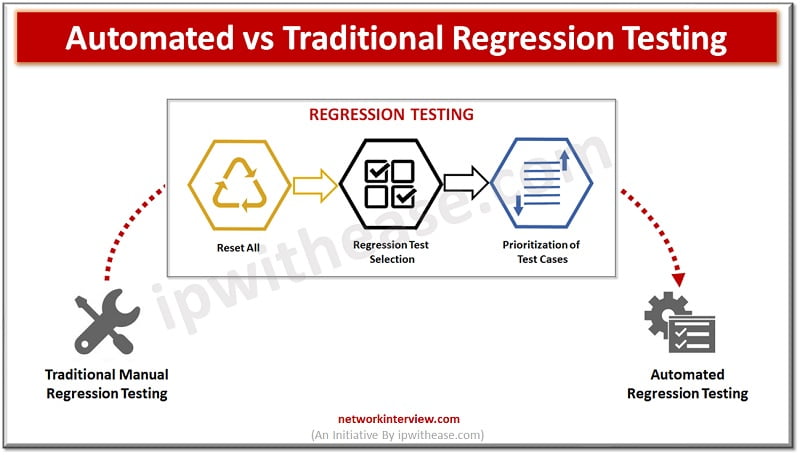
Automated vs Traditional Regression: A Comparative Analysis
In the field of software development, testing procedures are always changing as a result of the desire to produce high-quality products while preserving agility. Regression testing is one of them and is crucial in verifying that new code changes don’t negatively impact current functions.
Two main strategies, traditional manual regression testing and the gaining in popularity of automated regression testing, have evolved throughout time. In order to shed light on the circumstances in which each strategy performs best, we will now examine the traits, advantages, disadvantages, and factors related to both approaches.
Manual/ Traditional Regression Testing
Characteristics
Let’s find out how to do regression testing the traditional way. Traditional regression testing is the time-honored practice of manually running test cases to verify that current functions are preserved following code modifications. In order to ensure that no regressions have taken place, testers navigate the program using prepared scripts.
Benefits
1. In-depth Exploration
Through more natural exploration of the program during manual testing, testers may find edge situations and scenarios that automated tests would not catch.
2. Resilience
Testers are flexible enough to respond quickly to unforeseen circumstances and changes in the application.
3. Initial testing
Even before a stable version of the application is ready, manual testing can be carried out early in the development process.
Drawbacks
1. Time and Resource Intensive
Because manual testing requires a lot of work and takes a long time, it is less ideal for projects with frequent code updates or short deadlines.
2. Human Error
Human error can affect manual testing, producing inconsistent findings and missing problems.
3. Limitations on Reusability
Reusability and efficiency are limited since test cases must be manually run each time.
Considerations
For smaller projects or when exploratory testing is essential, traditional manual regression testing might be useful. The demands of quickly changing software development cycles, however, may make it difficult for it to stay up.
Automated Regression Testing
Characteristics
The process of automating the execution of preset test cases is known as automated regression testing. These scripts replicate user interactions, making it possible to test an application quickly and consistently.
Benefits
1. Speed and Effectiveness
In projects with frequent code changes and fast release cycles, automated tests may be run rapidly and often.
2. Resilience
Human testers’ inherent unpredictability is eliminated by automated testing, guaranteeing consistency in test execution.
3. Coverage
Test coverage may be improved by using automated tests, which can cover a variety of scenarios and functionality.
4. Regression Detection
Automated testing may find regressions early in the development phase, avoiding production flaws.
5. Reusability
Test scripts may be used again and again for various projects and iterations, saving time and effort.
Drawbacks
1. Initial Investment
Setting up automated tests requires an initial investment of time and resources to create and maintain test scripts.
2. Limited Exploratory Testing
Automated tests are scripted and may miss out on unexpected scenarios that can be discovered through manual exploration.
3. Maintenance
Automated tests need ongoing maintenance to keep them up-to-date with changes in the application.
Considerations
Automated regression testing is particularly advantageous for projects with a high rate of change, large codebases, and a need for rapid feedback. It becomes an essential component of Continuous Integration/Continuous Deployment (CI/CD) pipelines, facilitating early detection of regressions.
Choosing the Right Approach
Deciding between traditional manual regression testing and automated regression testing depends on several factors. Here are some considerations to help make the right choice:
1. Project Size and Complexity
Manual testing may be sufficient for simple projects with few functionality. However, the effectiveness and thoroughness of automated testing are advantageous for bigger and more complicated projects.
2. Release Cycle
Automated regression testing can keep up with the pace and deliver prompt response if your project necessitates frequent changes and short release cycles.
3. Resource Accessibility
Setting up and maintaining scripts for automated testing calls for technical expertise. When making a choice, take into account the knowledge that your team has.
4. Criticality of Functionality
For critical functionality, a combination of manual and automated testing may be required. Even while automated tests reliably catch regressions, manual testing may provide a more thorough analysis.
5. Budget and Time Restraints
Automated testing is long-term efficient, but it requires an initial investment. Consider your resources and timeline before deciding on a plan.
6. Needs for Exploratory Testing
If your project requires extensive exploratory testing to uncover unforeseen issues, manual testing may be a better choice.
Getting the Balance Right
You actually don’t always have to choose between automated and manual regression testing. A lot of development teams have found it better to strike a balance between the two different approaches. The approach of hybrid testing allows testers to focus on exploratory testing and activities that require human intuition by automating repetitive and time-consuming chores.
By combining the two approaches, teams may take advantage of the benefits of each strategy, and even end up boosting testing productivity. This hybrid technique can be especially useful when the thoroughness and adaptability of human testing are combined with the efficiency and reliability of automated testing.
The decision between automated and manual regression testing really doesn’t even have to be made. Each technique offers a unique mix of benefits and limitations. While conventional manual testing offers the flexibility of exploratory testing and can be useful for smaller projects, automation testing benefits in scenarios with high levels of speed and frequent code changes.
A final decision should be taken in consideration of the project’s requirements, resources available, and overall development strategy. By striking the right balance between automated and manual regression testing, a complete testing strategy that preserves the quality and stability of software applications in the dynamic environment of modern software development may be achieved.
Continue Reading:
Top 10 trends in Automation Testing Tools
8 Key Software Testing Methods



